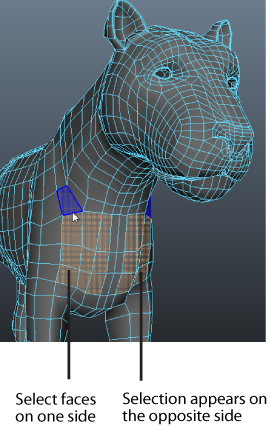
Symmetry in Maya is selection-based. When symmetry is turned on, the selected component(s) and the component(s) on the opposite side of the mesh are included in the selection, letting you perform selection-based polygonal modeling operations with symmetry. The current Symmetry setting persists from one tool to another.
Topological symmetry
If your model is topologically symmetrical but is posed in an asymmetrical manner or contains vertices that overlap in 3D space, you can still edit your mesh using topological symmetry. Unlike the other symmetry modes, World and Object, which rely on 3D space to determine points of symmetry, topological symmetry uses the model's topology to find symmetrical components. For more information about these symmetry modes, see Symmetry Settings in the Select Tool.
To use topological symmetry on a mesh, it must have an equal number of faces on each half, and an edge must run down the center line of the mesh, with no faces that straddle the center line. When you activate topological symmetry on a mesh that is not topologically symmetrical, partial topological symmetry activates by default. You can use partial topological symmetry to edit parts of a mesh that are symmetrical, even if the mesh is not symmetrical overall. See Edit a mesh with topological symmetry.